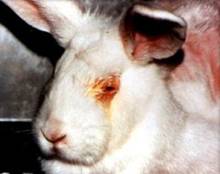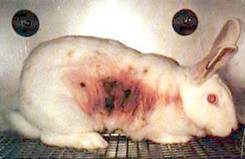
Tests on pharmaceutical products involve: Metabolic Tests - Which are performed to find out how the drugs are absorbed, metabolized and excreted by the body when introduced orally, intravenously, intraperitoneally, or intramuscularly. Toxicology Tests - Acute toxicity is studied by using a rising dose until signs of toxicity become apparent. Sub-acute toxicity is where the drug is given to the animals for four to six weeks in doses below the level at which is becomes toxic, in order to discover the effects of the build up of toxic metabolites. Testing for chronic toxicity can last up to two years. The data gained from this period can be used to calculate the maximum tolerable does; that is, the does where signs of toxicity begin to occur. Efficacy Studies - Which test whether experimental drugs work by inducing the appropriate illness in animals using an animal model of the disease. The drug is then administered in a randomized trial. This is intended to allow scientists to determine the effect of the drug and dose response curve. Using animal testing in the development of cosmetics involves a number of separate practices: 1. Testing a finished product such as lipstick; 2. Testing individual ingredients, or a combination of them; 3. Contracting a third-party company to perform any of the above; 4. Using a subsidiary or third-party company to perform the tests in countries where animal testing is not banned. Some cosmetics companies claim that their products are not tested on animals despite using one or more of the methods listed above. |
|||
 |
 |
Skin and eye irritancy tests performed on living rabbits. | |
All these experiments are un-necessary and potentially dangerous to human health, and above all extremely cruel. Non-human animals have different biological structures and physiology that humans. Thus, an animal’s response to a drug can be similar or different to a human’s, and it is impossible to extrapolate what the reaction will be in a human being, For example: morphine calms humans but excites cats, cortisone causes birth defects in mice but not in humans, penicillin kills guinea pigs and hamsters and aspirin poisons cats. If the results of tests on animals had been relied upon we would not have penicillin or digitalis (a drug used by heart patients but which was withheld for a long time because it was found to raise blood pressure of dogs). We would also be without chloroform (once a common anesthetic but not used initially because it was toxic to dogs) and aspirin (which causes fetal deformities in rats and is toxic to certain animals). Certain steroids, adrenaline, insulin, and some antibiotics are also toxic to many animals but medically beneficial to humans. Animals suffer greatly from procedures carried out on them. Such procedures include; applying substance to the eyes of conscious animals in order to test irritancy, applying substances on shaved skin, frequently a braised or broken to increase absorption, burning them, breaking their skulls and implanting electrodes...etc. As many undercover investigations have proven, animal cruelty legislations, where they exist, do not prevent researchers from abusing and mistreating animals. Even when not being poisoned or mutilated in actual experiments, the lives of animals in laboratories and nightmarish. Many spend the entirety of their lives in small, barren metal cages. The isolation and boredom alone often cause social animals to become psychotic. Animals in laboratories are viewed merely as objects, Their ability to suffer and feel is denied and disregarded. As mere “ test subjects” they are handled roughly, with no thought to their distress, fear or pain. When not being experimented on, these animals still enjoy no comfort at all, sleeping on cement or metal flooring. Those who do survive the experiments are then “sacrificed”...callously killed and tossed aside. Animals experience pain, fear, pleasure, and have as much right to life and be protected from cruelty as human beings. We should not have the right to imprison and torture animals for out own benefit. Alternatives Successful alternatives include test tube studies on human cells, tissues and organ cultures, epidemiological studies and computer models. Cosmetic manufacturers who genuinely do not test on animals generally use the following for safety testing of their products; Reliance on existing natural or synthetic ingredients, compounds and substances, which have already been extensively tested on animals; Avoiding novel ingredients or combinations or ingredients that have not been fully tested and may not be safe; Testing on human volunteers/clinical trials. WHAT YOU CAN DO! Buy household products and cosmetics not tested on animals: Check out our link to cruelty-free companies. Support charities that use modern, effective methods to do research into human diseases without torturing animals. |
|||
|
|||